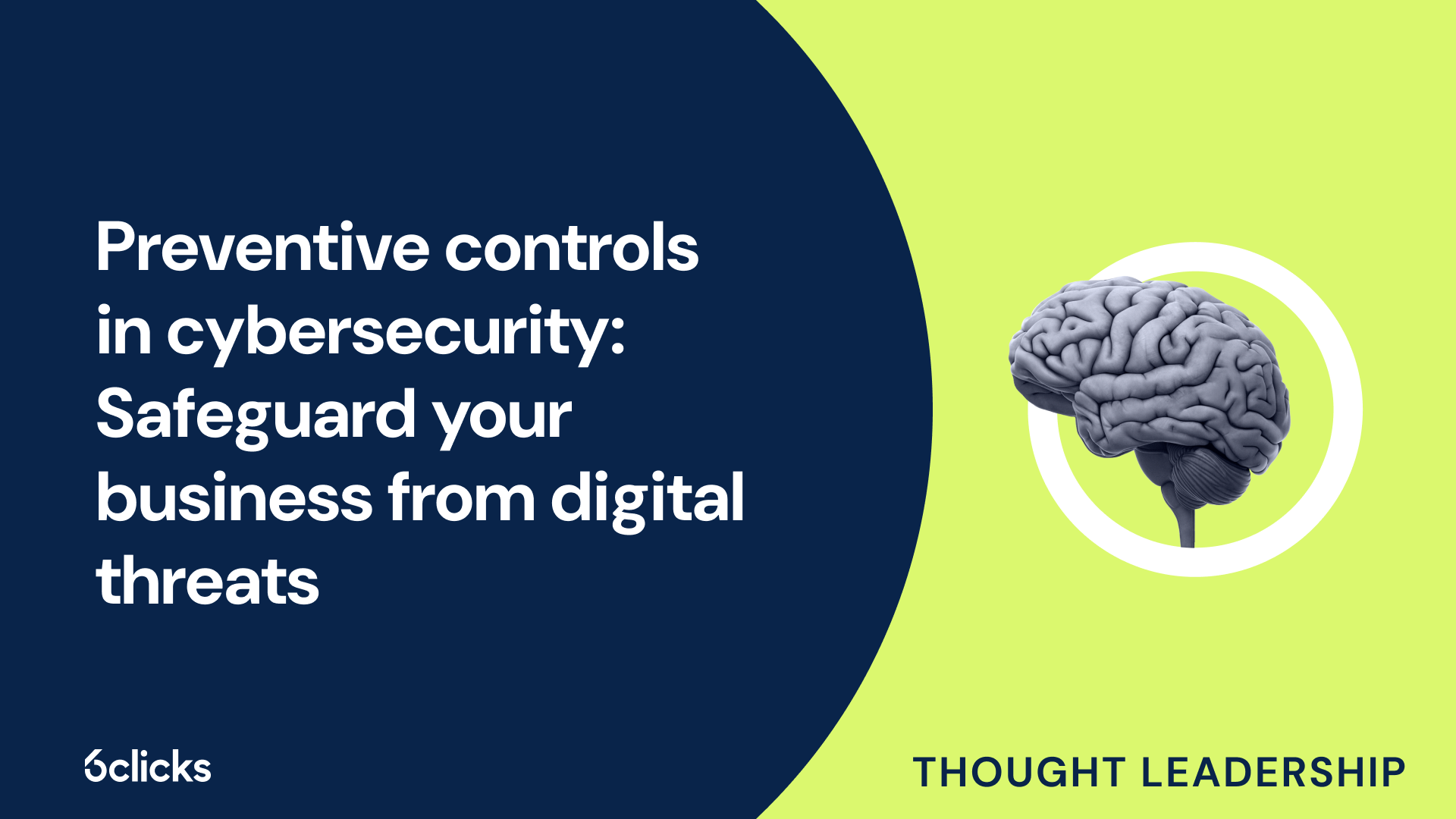
In today’s increasingly complex threat landscape, waiting to react is no longer an option. Cybersecurity now demands a proactive, layered approach, with preventive controls forming the first line of defense. These security controls—ranging from access restrictions to risk assessments—are designed to stop threats before they materialize. For organizations, understanding and implementing preventive controls is critical to reducing risk, protecting assets, and maintaining business continuity. Let’s take a look at the different strategies organizations should adopt to build a resilient, end-to-end security program.
The shift from reactive to proactive security
Traditionally, many organizations approached cybersecurity reactively; responding only after breaches occurred. However, with threat actors becoming faster, more sophisticated, and more persistent, that approach is no longer sustainable.
Proactive security strategies prioritize prevention. By anticipating vulnerabilities and implementing measures that deter or block attacks, organizations can reduce both the frequency and impact of incidents. This equips organizations with:
-
A reduced attack surface: By minimizing unnecessary access points and vulnerabilities, organizations make it harder for attackers to find an entry route.
-
Minimized business disruptions: Proactive controls help detect and contain threats early, limiting their ability to affect critical systems or operations.
-
Improved compliance posture: Preventive controls ensure alignment with standards and regulatory frameworks like ISO 27001, CMMC, the Australian Information Security Manual (ISM), and SOC 2, reducing security gaps and the risk of non-compliance.
-
Lower recovery costs: By preventing incidents or reducing their impact, organizations avoid the high costs of downtime and reputational damage.
Adopting a proactive mindset enables security and compliance leaders to shift from firefighting to foresight, protecting their organizations with speed, structure, and strategic control.
Key preventive controls every business should implement
No single control can prevent every attack. Instead, organizations must deploy a comprehensive set of safeguards that cover users, systems, data, and infrastructure. Below are the foundational preventive controls every business should prioritize.
.png?width=1920&height=1080&name=6clicks%20blog%20-%20Preventive%20controls%20(1).png)
Governance: Risk assessment and employee training
Effective cybersecurity starts with strong governance. Organizations must understand their threat landscape, define acceptable risk thresholds, and ensure that teams are equipped to respond appropriately.
Risk assessments are foundational to this process. They help identify vulnerabilities, assess potential impacts, prioritize remediation efforts, and inform the selection of appropriate controls. Best practices include:
-
Establishing a consistent risk taxonomy to align teams, streamline data capture, and enable more effective risk analysis and reporting.
-
Incorporating both internal and external data, including threat intelligence and business context, for a more accurate view of risk exposure.
-
Conducting risk assessments and updating risk registers regularly, especially when there are changes to technology, processes, or regulatory requirements.

Platforms like 6clicks streamline risk assessments with powerful risk registers and AI-powered capabilities. With 6clicks, you can catalog and track risks in one centralized system, enforce your risk taxonomy using customizable data fields and workflows, link risks to controls and assets for seamless integration across your security landscape, and use AI to automate risk identification and treatment.
Meanwhile, employee training plays a crucial role in strengthening the human layer of defense. Human error remains a leading cause of breaches, from misconfigurations to phishing. Delivering security training and awareness programs during onboarding and on a recurring basis can help employees recognize and avoid threats.
Access control: Role-based permissions and least privilege principles
Access control is more than just user permissions. It’s a foundational security discipline that limits risk exposure by ensuring only the right individuals have access to the right systems, data, and operations at the right time.
Role-based access control (RBAC) assigns permissions based on job functions, reducing manual configurations. Least privilege restricts users to the minimum access required to perform their roles, limiting exposure in case of credential compromise.
Best practices:
-
Automate access provisioning and deprovisioning using identity governance tools to prevent permission creep and orphaned accounts.
-
Perform regular entitlement reviews, especially for privileged accounts, to reduce the risk of excessive or outdated access.
-
Integrate with a centralized identity and access management (IAM) system to ensure consistent policy enforcement across cloud, on-prem, and third-party environments.
Network security: Firewalls and network segmentation
Network security forms the perimeter and internal backbone of any cyber defense strategy. Preventive controls in this domain aim to restrict unauthorized access, limit lateral movement, and isolate critical systems to contain potential breaches.
Firewalls inspect traffic and enforce rules to block malicious activity. Network segmentation divides your network into isolated zones based on business function or data sensitivity, minimizing exposure in case of compromise.
Best practices:
-
Deploy next-generation firewalls (NGFWs) that adapt based on user identity, device posture, and application behavior.
-
Implement segmentation around high-value assets and systems, such as finance, R&D, or operational technology environments.
-
Use zero trust principles to enforce continuous verification and limit implicit trust within and across network zones.
Authentication: MFA and strong password policies
Authentication serves as the gatekeeper to your systems and data, verifying the identity of users before granting access. As credential-based attacks continue to rise, ranging from brute force attempts to credential stuffing and phishing, strengthening authentication mechanisms is one of the most critical preventive controls in any cybersecurity strategy.
Combining strong password policies that enforce complexity, length, rotation, and uniqueness, with multi-factor authentication (MFA) which requires two or more forms of user verification, significantly reduces the risk of unauthorized access.
Best practices:
-
Mandate MFA for all users, especially privileged and remote accounts.
-
Enforce password hygiene through policy and tooling, including minimum character sets, breach detection checks, and lockout thresholds.
-
Implement single sign-on (SSO) to reduce password sprawl and centralize authentication across systems, reducing both user friction and risk.
Encryption: Protecting data at rest and in transit
Encryption is a foundational control for maintaining data confidentiality and integrity, particularly in environments handling sensitive, regulated, or mission-critical information. It ensures that even if data is intercepted or accessed unlawfully, it remains unreadable without the appropriate decryption keys.
Data at rest (e.g., on disks or databases) should be encrypted using strong, industry-standard algorithms. Meanwhile, data in transit, including internal communications like emails and data exchanges over networks, should be protected using secure transport protocols such as TLS (Transport Layer Security) or IPsec VPNs.
Best practices:
-
Implement centralized key management systems (KMS) to maintain control over cryptographic keys, enforce rotation policies, and enable auditability.
-
Encrypt backups and sensitive configuration files.
-
Validate encryption configurations regularly as part of vulnerability assessments and compliance checks.
System maintenance: Regular software updates and patch management
Maintaining secure systems requires more than simply turning on auto-updates. It demands a disciplined, proactive approach to software maintenance to address vulnerabilities before they can be exploited.
Regular software updates, such as feature updates and bug fixes, play a preventive role by eliminating outdated code, closing security gaps, and maintaining compatibility with modern security protocols. Patch management processes enable the structured and timely application of updates across systems and third-party applications.
Best practices:
-
Maintain an inventory of all assets and software versions to avoid blind spots.
-
Automate where possible and prioritize patches based on severity and exposure.
-
Test patches in staging environments before deployment to minimize disruption and ensure stability across production systems.
When implemented together, these preventive controls form a cohesive defense strategy that reduces risk exposure and builds the foundation for continuous compliance.

Modern GRC platforms like 6clicks automate many of these preventive processes, including risk assessments, policy enforcement, and control setup—freeing up valuable time for security teams and ensuring consistency across the organization.
Go beyond prevention: Integrate detective and corrective controls for full coverage
While preventive controls form the first line of defense, they are not foolproof. Even the most well-architected security programs can face unforeseen threats, misconfigurations, or insider activity. That’s why a mature cybersecurity strategy must also incorporate detective and corrective controls, empowering organizations to quickly detect deviations, respond to incidents, and recover operations without lasting damage.
Continuous control monitoring and regular audits for assurance
Detective controls validate that preventive measures are working and highlight gaps in compliance or performance. Two of the most critical detective safeguards are continuous control monitoring (CCM) and regular audits—both of which serve to reinforce accountability, compliance, and trust.
Continuous control monitoring tracks control performance in real time through automation, providing alerts for control failures and anomalies. On the other hand, internal and external audits assess control design and effectiveness, ensure compliance with standards and regulatory requirements, and identify areas for improvement.

6clicks offers built-in CCM and audit capabilities that allow you to automate control testing using integrations with cloud security tools like Microsoft Defender for Cloud and Wiz, automatically raise risks and issues from audit findings, and drive prompt action from identification to remediation—all within a single platform.
Incident response and disaster recovery planning for operational resilience
Corrective controls are essential for minimizing the impact of security incidents and ensuring business continuity when things go wrong.
Incident response plans define roles, communication protocols, and remediation steps following a security event, while disaster recovery planning ensures data and system availability after a major disruption. These measures enable organizations to contain threats quickly, recover critical operations, and address root causes to prevent recurrence.
6clicks supports operational resilience through integrated incident management capabilities. Teams can log incidents, assign ownership, track response steps, and link remediation activities to risks, controls, or audit findings, creating a closed loop from detection to resolution.
Together, these control types extend your risk coverage beyond prevention, forming a complete security posture that is dynamic, assurance-driven, and resilient.
Conclusion: Building a resilient cybersecurity strategy
To sum it up, preventive controls form the backbone of a proactive cybersecurity strategy, but they are most effective when combined with detective and corrective measures. For CISOs and compliance leaders, the goal isn’t just to stop breaches: it’s to build a resilient, adaptive defense that evolves with the threat landscape.
By leveraging automation, AI, and integrated platforms like 6clicks, organizations can streamline their control environment, reduce manual effort, and gain real-time visibility into risks and responses. The result? A security program that’s not only compliant but confident, efficient, and future-ready.
Get started with 6clicks
Simplify control implementation, automate compliance, and enable proactive risk management with an all-in-one, AI-powered GRC platform:
-
Centralize control management, assign ownership and control responsibilities, and track ongoing compliance and control effectiveness through Continuous Control Monitoring
-
Easily align controls with compliance requirements using Hailey AI, which can map your controls to frameworks and identify gaps within seconds
-
Leverage AI to automate various processes such as extracting controls from policy documents, generating audit responses based on existing data, and creating remediation tasks
-
Get free access to ready-to-use content such as standards and regulations, control sets, risk libraries, and assessment templates with an extensive Content Library
-
Streamline audit readiness with automated workflows, reporting, and evidence collection


